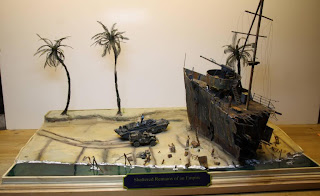
Scale Modelling
One/35 Scale Modelling Dioramas
Welcome to Outoppies Scale Modelling and Dioramas Blog
Sunday, December 27, 2009
Tuesday, December 8, 2009
Saturday, December 5, 2009
Dragon changing direction

Despite what war movies might purport to show, the majority of a soldier’s time is not spent in frontline combat. Dragon’s latest 1/35 scale figure set is thus an accurate portrayal of a war scene, for it shows German soldiers performing various mundane but nevertheless essential activities. Buckling up a belt, adjusting a chin strap, taking off a tunic or putting on personal gear are pretty ordinary events, but these are exactly the kind of things these five figures are doing. While perhaps not as dramatic as firing a weapon or performing a bayonet charge, these kinds of actions are certain to lend an air of authenticity to a modeler’s dioram a.
The German figures represent the early-war period, suitable for any European theater in 1940-41. Each figure is masterfully molded and anatomically accurate. The faces are carefully scuplted, as are their everyday actions. They wear a variety of uniforms, including three Wehrmacht soldiers dressed in typical M1935 field gray tunics, trousers and leather boots. Meanwhile, one figure is kitted out as a Panzer crewman, while the final one would suit a Sturmartillerie unit. Modelers are always clamoring for more figures to populate their dioramas and vignettes, and they don’t come any more practical than
Sunday, November 29, 2009
Biggest Diorama? Roadside America Pennsylvania




Probably the coolest exhibit of all time: a 9335-sq-ft mini New York called the Panorama, with each building in the city shown. You walk in to one side, and go up a ramp encircling the......
http://www.queensmuseum.org/exhibitions/visitpanorama

http://www.modellmarine.de/index.php?option=com_content&view=article&id=827&Itemid=4338
Sunday, November 22, 2009
Saturday, November 21, 2009
Dragon's latest figures

1/35 "Fragile
After
Sunday, November 15, 2009
Sunday, November 8, 2009
Thursday, October 22, 2009
Sunday, October 11, 2009
1/6th scale house



http://www.armorama.com/modules.php?op=modload&name=SquawkBox&file=index&req=viewtopic&topic_id=136308&page=1 (this guy has been at this build for x3 years in 1/6th scale)
The Workshop Scale Art Modelling

http://www.network54.com/Forum/110741/thread/1253551923/The+Workshop
Friday, October 9, 2009
Wednesday, October 7, 2009
Tuesday, October 6, 2009
Capturing Clervaux

http://www.armorama.com/modules.php?op=modload&name=SquawkBox&file=index&req=viewtopic&topic_id=131960&page=6
 Look at the scale of this dio!
Look at the scale of this dio!
http://www.diorama-clervaux.com/
http://www.armorama.com/modules.php?op=modload&name=News&file=article&sid=5810
read launch article here and see more pics elsewhere on this blog, follow the labels on the sidebar!
http://www.armorama.com/modules.php?op=modload&name=SquawkBox&file=index&req=viewtopic&topic_id=150876&page=12#1392087
Saturday, September 19, 2009
Friday, September 18, 2009
Miniature Figures
Tuesday, September 15, 2009
Dave Revelia’s incredible Tractor Repair Shed



or
http://images.google.co.za/imgres?imgurl=http://www.polyweb.com/dans_rr/NarrowGauge2004/images/nngcday2a059_69.jpg&imgrefurl=http://www.polyweb.com/dans_rr/blog/index.php/about/&usg=__v-4el3qcmUhXAzvjtcWUtHKqmBU=&h=768&w=1024&sz=172&hl=en&start=54&sig2=X96jiI1KFFHk_Amhfocedw&um=1&tbnid=91Jky7pjiTGhyM:&tbnh=113&tbnw=150&prev=/images%3Fq%3D35th%2Bscale%2Bdiorama%2Bdisplays%26ndsp%3D18%26hl%3Den%26sa%3DN%26start%3D36%26um%3D1&ei=h9pfS5T3IdyN4ga79dCqDA


































